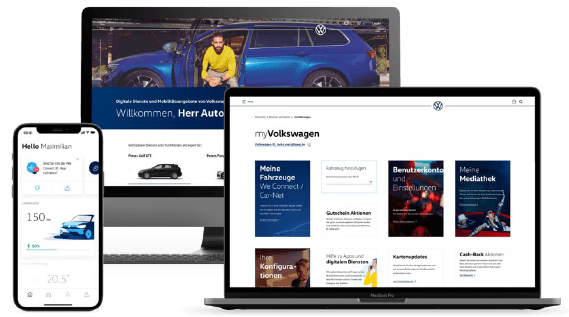
USER-FIRST CONTENT STRATEGIES
Expert agency for UX Writing and Content Design
Expertise that drives results:
- Dedicated project teams for UX Writing and Content Design
- Multilingual UX content for websites, apps, and e-commerce platforms
- Trainings, workshops, and coaching sessions led by our UX experts
Ready to write like a pro? Start with the UX writing basics in our Academy.
As an agency for UX writing and content design, we help companies embed this discipline into their agile product development. Through close collaboration between UX writers, UX/UI designers, developers, and product owners, we create digital products with seamless, intuitive user journeys. The result: happier users and higher conversions—whether it’s for your website, app, or online store. Curious to learn more about UX writing and how it differs from traditional copy? This page offers a deep dive into this exciting and fast-evolving field.
"In UX writing, users come first: clear and concise content encourages action and guides them toward their goal."
UX WRITING AND CONTENT DESIGN
Better user experience thanks to UX writing
Why UX writing matters
UX writing includes all textual elements that shape the user experience. While still a relatively young discipline, it has quickly grown into a specialized field within UX. In the early days, writing for websites, apps, and digital products was often handled by developers or designers. But as digitalization advanced in the early 2000s, the importance of language in UX became clear. UX writing helps users understand software and interact with digital products in a smooth, intuitive way. Great UX copy does more than remove language barriers—it improves the overall user experience. And when people can easily reach their goals, they’re more likely to return to the product. That’s why UX writing also helps increase conversions for websites, apps, and online shops.
How qwp supports your UX with end-to-end writing services
We help companies and UX teams boost their user experience through expert UX writing.
As an agency, we offer a variety of service models and seamlessly integrate into agile teams. Our work begins with a detailed analysis of your product’s current language and structure. Through workshops, training sessions, and testing, we help you build a cohesive UX copy strategy. Our UX writers work directly with your designers, developers, and product owners, ideally from day one. Need more support? We also offer assistance with user testing, localization, terminology, translation, and rollout planning.
Once the strategy is in place, we get to work: crafting dialogs, microcopy, and interface texts that are clear, concise, and to the point. This helps make your product more usable, intuitive, and accessible—whether it’s a website or an app.
UX COPYWRITING: THE POWER OF SMALL WORDS
What kinds of content do UX writers create?
- Microcopy
Buttons, links, headlines, labels, tooltips, 404 pages, form fields, status and feedback messages (success, loading, failure) - Botcopy
Dialogues for chatbots and voice assistants
- Short & Long Copy
Website texts, product descriptions, category pages, teasers, onboarding texts, tutorials, FAQ - Concept copy
Usage scenarios, personas, storyboards
UX WRITING & CONTENT DESIGN
How holistic user experience can grow
UX writing: the underrated hero of user experience
Without text, apps and websites would be nothing more than shapes, lines, and icons. It’s language that makes digital products truly usable. Good microcopy is clear, concise, and conversational—shaped to fit the interface. But it also goes further, communicating your brand values across the entire user experience.
Tone of voice: shaping your brand personality
Design choices like colors, typography, and layout shape how your product feels. Sepia tones suggest nostalgia. Blue evokes calm and clarity. Sans serif fonts feel modern. And text plays an equally powerful role: the tone can be relaxed or formal, enthusiastic and authentic, or professional and neutral. Only when visual design and copy work together can your brand message come through.
A red button that says "Buy now" will feel very different from a subtle blue link that says "Learn more." A cookie banner with a small illustration and a line like "I love cookies" can add charm to a required interaction. And a well-placed 404 page with copy like "This page is on a coffee break" can turn frustration into a smile, when used in the right context.
We help you define a tone of voice that fits your brand and corporate design. We also support gender-inclusive language and terminology when needed.
What our UX writers focus on
10 rules for UX copywriting
- Talk to the user: The interface speaks to the user like a friend—asking clear questions they can respond to with a click.
- Know the audience: As with any great content, UX writing is tailored to the users. Technical terms are only used when they're understood.
- Get to the point: Clear and simple language works best. Short sentences beat long, complicated ones, especially when users are in a hurry.
- Create a clear hierarchy: Information is structured from the user’s perspective. Key messages are highlighted and placed where they’ll be noticed first.
- Structure content logically: Short paragraphs, subheadings, and bullet points help make text easier to scan and prevent overwhelming walls of copy.
- Use active language: The more everyday and active the language, the easier it is to understand. Passive voice and nominalizations are avoided.
- Be consistent: Language, style, and terminology follow clear rules across the interface. That makes content easier to understand and to translate.
- Write clear calls to action: Buttons and links should use direct, action-oriented language—so users always know what to do next.
- Support the text visually: Words and design go hand in hand. Icons, images, and videos help clarify and reinforce the message.
- Test and improve: UX writing is iterative. Text is reviewed and refined regularly to ensure it meets user needs and contributes to a better experience.
Trusted by companies across industries






All trademarks, logos, and brand names are the property of their respective owners.
The Experts in User Experience
Featured case study

UX Writing for myVolkswagen
UX writing for software applications
How does UX writing work for websites, apps, and online stores?
What makes good UX writing and content design on websites?
Digital content isn’t read like printed books—it’s scanned. Eye-tracking studies have shown that people often skip ahead after just a few lines.
That’s why clear content structure and logical information architecture are essential. It starts with navigation: Is it visible? Flat or deep hierarchy? How many menu items are there, and how are they labeled? These are all strategic content decisions. UX content design also includes the conceptual and visual design of digital content. A clear content structure with subheadings, short paragraphs, and bullet points helps users absorb and remember what they’ve read. White space gives the content room to breathe.
How UX writing improves the user journey in online stores and booking platforms
In online shops and booking platforms for hotels, travel, or restaurants, the user is also a customer. So UX writing focuses on guiding users clearly through the checkout or booking process. If the content is unclear or inconsistent, users might abandon the purchase. Clear, concise messages, especially in buttons, can improve conversion rates. The user should always know what will happen next when clicking—whether they add an item to their cart or place an order. Clear labels like “Add to cart,” “Book now,” or “Proceed to checkout” help users complete tasks and boost sales.
Clear, concise, and helpful: what UX writing needs to deliver in apps
Short, clear, compact: UX copywriting for apps is all about text length. The viewport of smartphones is small and should be used as effectively as possible. UX writers need to guide the user through the app in just a few words and ensure a positive user experience. Even on the narrow smartphone display, all information should be intuitive and everything important should be recognizable and, above all, understandable at first glance. This is why many software applications rely on icons and animations that visually clarify the short text. For example, happy emojis or green ticks confirm the success of an action, while red crosses or sad smileys signal failure. In this case, a measure or alternative should be suggested to the user so that they want to continue using the app.
AT THE INTERSECTION OF HUMANS AND MACHINES
Which frontends and user interfaces benefit from UX writing?
- Websites: UX writing guides users through the interface, draws attention to actions, and provides feedback.
- Mobile apps: In mobile apps, concise and clear text helps users navigate the interface with ease.
- Chatbots: A conversational UI should feel natural and human. UX writing shapes the dialogue to be intuitive and user-friendly.
- Voice assistants: With voice user interfaces, UX copy enables a natural, spoken interaction between user and product.
- E-commerce platforms: In e-commerce, texts guide users through the ordering process and motivate them to interact, i.e. to buy.
- Booking portals: Whether for hotels, flights, or restaurants—clear, accessible UX copy improves usability and drives conversions.
- Onboarding processes: UX writing supports users from the very first step, helping them interact with digital products and building trust along the way.
- IoT products: New technologies in the smart home—like intelligent coffee machines or highly complex medical devices—all fall under the Internet of Things and need clear, helpful text to make them easy to use.
FAQ
Frequently asked questions
What is UX writing?
What do UX writers do?
What is content design?
What is tone of voice?

The Experts in User Experience
What sets us apart

UX
Expertise
Multimedia user experiences that drive satisfaction and boost conversions

Content Scaling
Know-How
Global rollouts and optimized localization thanks to efficient tools and workflows

Project Teams With Local Expertise
A global network of native-language content and UX professionals

Agile
Methodology
Fast, flexible, and effective implementation using SCRUM and SAFe
The Experts in User Experience
How we help you go further
Get in touch
Smart solutions, made for you.
Your users are our priority: in every piece of copy and at every touchpoint, across the globe. We help you optimize the user experience of your mobile apps, websites, or online stores. And scale your products and content internationally.

Brendan Reiswich
Business Development Manager
Phone: +49 30 30809311



